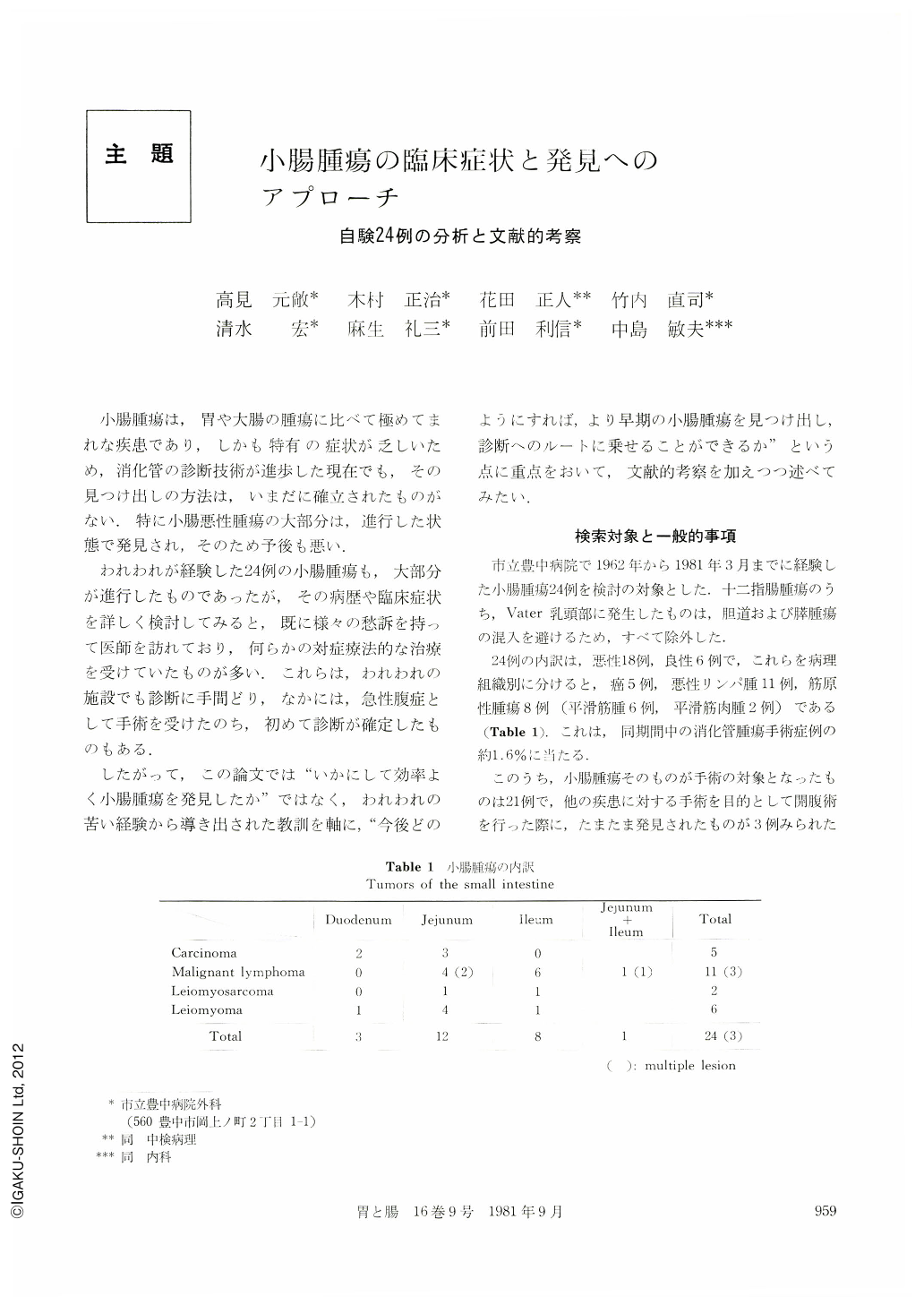Japanese
English
- 有料閲覧
- Abstract 文献概要
- 1ページ目 Look Inside
- サイト内被引用 Cited by
小腸腫瘍は,胃や大腸の腫瘍に比べて極めてまれな疾患であり,しかも特有の症状が乏しいため,消化管の診断技術が進歩した現在でも,その見つけ出しの方法は,いまだに確立されたものがない.特に小腸悪性腫瘍の大部分は,進行した状態で発見され,そのため予後も悪い.
われわれが経験した24例の小腸腫瘍も,大部分が進行したものであったが,その病歴や臨床症状を詳しく検討してみると,既に様々の愁訴を持って医師を訪れており,何らかの対症療法的な治療を受けていたものが多い.これらは,われわれの施設でも診断に手間どり,なかには,急性腹症として手術を受けたのち,初めて診断が確定したものもある.
Primary neoplasms of the small intestine, though their incidence is very low compared with that of tumors arising in other sites of the gastrointestinal tract, have continued to provide a challenging problem for the physician. The unawareness of the existence of small bowel tumors as well as the paucity of any specific symptomatology in these disorders apparently results in a delay in diagnosis and cure.
In this communication, we present our experience with 24 patients with primary small bowel tumors, and their clinical manifestations were analyzed in an attempt to define the guidelines for diagnosing or suspecting these lesions clinically. All of the 24 patients were subjected to operation in our institution during about a 19-year period of time from January 1962 to March 1981. The microscopic diagnoses were available in all cases, which included 18 malignant tumors (11 primary malignant lymphomas of the small intestine, five adenocarcinomas, and two leiomyosarcomas) and six benign tumors (all of the latter group were leiomyomas); in this series no instances of carcinoid tumor were encountered, although it is a relatively common tumor of the small intestine in reported series from western countries.
Although there were no constant signs and ymptoms referrable to these tumors in general, several diagnostic features of interest are summarized below.
(1) Malignant tumors of the small intestine occur generally in middleaged persons or later in life. In the 18 patients with malignant lesions in our series, a medium age was 58 years, and all but three patients (83percent) were over 40. There was no difference in the age distribution between patients with carcinoma and those with malignant lymphoma.
(2) When a tumor is found incidentally at operation in the small bowel, it is nearly always benign. Of the 24 patients with small bowel tumors, 21 (87.5 per cent) had symptoms referrable to their lesions; when three patients were found to have incidental tumors in the small intestine at the time of operation for other gastrointestinal disorders, all of these asymptomatic tumors were benign (two large and one small leiomyomas).
(3) The main clinical manifestations in patients with small bowel tumors in general include abdourinal pain, chronic or acute obstruction, massive intestinal bleeding (melena), perforation with signs of peritonitis, and a palpable mass. The mode of clinical presentation and its cause in individual cases, however, may differ by a specific tumor type. Obstruction was common in both patients with carcinoma and malignant lymphoma; in carcinoma patients it was due to constriction of the affected segment of bowel by tumor, whereas in four of the six malignant lymphoma patients who had obstruction it was a result of intussusception. Massive bleeding is more common in patients with submucosal tumors. Five of the seven patients who had melena were cases of myogenic tumors (three leiomyomas and two leiomyosarcomas). Perforation occurred more frequently in malignant lymphoma (four out of 11) than in carcinoma (one out of five).
(4) This retrospective study of patients with small bowel tumors indicate the difficulty of early recognition of the disease even in patients with some apparent symptoms. The clinical signs and symptoms encountered in these patients share in many respects with those present in disorders of other gastrointestinal tracts. Thus, it is essential that one should consider the possibility of small bowel tumors when lesions of the stomach, duodenum, and colorectal region are excluded by adequate examinations. Also, a careful routine examination of the upper intestine (jejunum) and ileocecal region during the study of upper GI series and barium enema may be of paramount importance, since both of these are asare the most frequent sites of development of small bowel cancers.

Copyright © 1981, Igaku-Shoin Ltd. All rights reserved.


